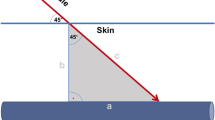Abstract
Objective:
To report the experience of peripheral insertion of double-lumen central catheters (PIDLCC) in preterm and term newborn infants and to analyze the technical characteristics of the procedure and any observed complications.
Study Design:
Retrospective review of 61 newborns that had a PIDLCC between 2003 and 2006. The study comprised clinical data analysis, anthropometrics, indications, duration, complications and reasons for withdrawal of the catheters.
Result:
Weight of the patients was <1 kg in 10%, and >2 kg in 75%. Catheters tip placement was as aimed, mostly superior cava vein (SCV), in 65.5%, and subclavian vein in remaining 34.5% and average duration of catheterization was 13.5±9.6 and 8.9±5.8 days, respectively. Blood sampling through both lumens was possible especially when the tip was at SCV. Reasons for catheter withdrawal were end of indication (45.9%), phlebitis/edema (21.3%), suspected infection (3.2%), accidental withdrawal (3.2%) and rupture of proximal end (3.2%). In three (4.9%) patients, withdrawal was due to serious complications (two cases of pleural leakage of infusion fluid and one breakage of the metallic guide). About 16.3% of the patients died with the catheter still in situ. Infection findings were positive tip culture (14.7%) and catheter-related sepsis (3.2%).
Conclusion:
Insertion of PIDLCC is possible in neonates. The incidence of complications, mostly mechanical, requires careful evaluation of indications, and strict adherence to the procedure of insertion and manipulation.
This is a preview of subscription content, access via your institution
Access options
Subscribe to this journal
Receive 12 print issues and online access
$259.00 per year
only $21.58 per issue
Buy this article
- Purchase on Springer Link
- Instant access to full article PDF
Prices may be subject to local taxes which are calculated during checkout

Similar content being viewed by others
References
Shaw JCL . Parenteral nutrition in the management of sick low birth weight infants. Pediatr Clin North Am 1973; 20: 333–358.
Wardle SP, Kelsall AWR, Yoxall CW, Subhedar NV . Percutaneous femoral arterial and venous catheterisation during neonatal intensive care. Arch Dis Child Fetal Neonatal Ed 2001; 85: F119–F122.
Cartwright DW . Central venous lines in neonates: a study of 2186 catheters. Arch Dis Child Fetal Neonatal Ed 2004; 89: F504–F508.
Wilson D, Verklan MT, Kennedy KA . Randomized trial of percutaneous central lines versus peripheral intravenous lines. J Perinatol 2007; 27: 92–96.
Valk WJ, Lien KD, Geven WB . Seldinger technique as an alternative approach for percutaneous insertion of hydrophilic polyurethane central venous catheters in newborns. J Perenter Enteral Nutr 1995; 19: 151–155.
Pardo de la Vega R, Los Arcos Sola M, Ferrero de la Mano L, Medina Villanueva A, Concha Torre A, Rey Galán C . Utilización de catéteres multilumen de acceso periférico como alternativa a las vías centrales. An Esp Pediatr 2002; 57: 18–21.
Seldinger SI . Catheter replacement of the needle in percutaneous arteriography; a new technique. Acta Radiol 1953; 39: 368–376.
Centers for Disease Control and Prevention. Guidelines for the prevention of intravascular catheter-related infections. MMWR 2002; 51 (No RR-10): 1–29.
Ares S, Pastor I, Quero J, Morreale de Escobar G . Thyroid complications, including overt hypothyroidism, related to the use of non-radiopaque silastic catheters for parenteral feeding in prematures requiring injection of small amounts of an iodinated contrast medium. Acta Paediatr 1995; 84: 579–581.
López Sastre JB, Fernández Colomer B, Coto Cotallo GD, Ramos Aparicio A . Estudio prospectivo sobre catéteres epicutáneos en neonatos. Grupo de hospitales Castrillo. An Esp Pediatr 2000; 53: 138–147.
Goñi Orayen C, Pérez Martínez A, Ruiz Cano R, Carrascosa Romero MC, Vázquez García MS, Martínez Gutierrez A . Accesos venosos centrales por técnica de Seldinger en neonatología. Cir Pediatr 1999; 12: 165–167.
Shah SP, Kalyn A, Satodia P, Dunn SM, Parvez B, Daneman A et al. A randomized, controlled trial of heparin versus placebo infusion to prolong the usability of peripherally placed percutaneous central venous catheters (PCVCs) in neonates: the heparin infusion for PCVC study. Pediatrics 2007; 119: e284–e291.
Lemarié C, Savagner C, Leboucher B, Le Bouedec S, Six P, Branger B . Bactériémies nosocomiales sur cathéters veineux centraux en néonatologie. Med Mal Infect 2006; 36: 213–218.
Klein MD, Rood K, Graham P . Central venous catheter sepsis in surgical newborns. Pediatr Surg Int 2003; 19: 529–532.
Mahieu LM, De Dooy JJ, Lenaerts AE, Ieven MM, De Muynck AO . Catheter manipulations and the risk of catheter-associated bloodstream infection in neonatal intensive care unit patients. J Hosp Infect 2001; 48: 20–26.
Garland JS, Alex CP, Mueller CD, Ottan D, Shivpuri C, Harris MC et al. A randomized trial comparing povidone-iodine to a chlorhexidine gluconate impregnated dressing for prevention of central venous catheter infections in neonates. Pediatrics 2001; 107: 1431–1436.
Knue M, Doellman D, Rabin K, Jacobs BR . The efficacy and safety of blood sampling through peripherally inserted central catheter devices in children. J Infus Nurs 2005; 28: 30–35.
Author information
Authors and Affiliations
Corresponding author
Rights and permissions
About this article
Cite this article
Bueno, T., Diz, A., Cervera, P. et al. Peripheral insertion of double-lumen central venous catheter using the Seldinger technique in newborns. J Perinatol 28, 282–286 (2008). https://doi.org/10.1038/sj.jp.7211923
Received:
Revised:
Accepted:
Published:
Issue Date:
DOI: https://doi.org/10.1038/sj.jp.7211923


